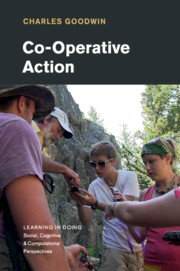Book contents
- Co-Operative Action
- Learning in Doing: Social, Cognitive and Computational Perspectives
- Co-Operative Action
- Copyright page
- Dedication
- Contents
- Figures
- Acknowledgments
- 1 What Is Co-Operative Action, and Why Is It Important?
- Part I Co-Operative Accumulative Action
- Part II Intertwined Semiosis
- 7 Intertwined Knowing
- 8 Building Action by Combining Different Kinds of Materials
- 9 Intertwined Actors
- 10 Projection and the Interactive Organization of Unfolding Experience
- 11 Projecting Upcoming Events to Accomplish Co-Operative Action
- Part III Embodied Interaction
- Part IV Co-Operative Action with Predecessors
- Part V Professional Vision, Transforming Sensory Experience into Types, and the Creation of Competent Inhabitants
- References Cited
- Index
- Series page
10 - Projection and the Interactive Organization of Unfolding Experience
from Part II - Intertwined Semiosis
Published online by Cambridge University Press: 03 November 2017
- Co-Operative Action
- Learning in Doing: Social, Cognitive and Computational Perspectives
- Co-Operative Action
- Copyright page
- Dedication
- Contents
- Figures
- Acknowledgments
- 1 What Is Co-Operative Action, and Why Is It Important?
- Part I Co-Operative Accumulative Action
- Part II Intertwined Semiosis
- 7 Intertwined Knowing
- 8 Building Action by Combining Different Kinds of Materials
- 9 Intertwined Actors
- 10 Projection and the Interactive Organization of Unfolding Experience
- 11 Projecting Upcoming Events to Accomplish Co-Operative Action
- Part III Embodied Interaction
- Part IV Co-Operative Action with Predecessors
- Part V Professional Vision, Transforming Sensory Experience into Types, and the Creation of Competent Inhabitants
- References Cited
- Index
- Series page
Summary
While earlier chapters investigated the intertwining of both differential states of knowledge and unlike materials, here analysis will turn to the calibration of experience in the midst of unfolding action. Assessments draw together a diverse collection of resources for the public display of stance, evaluation, and embodied experience. Syllables such as Ah:: that lack lexical content but carry expressive prosody enable a hearer not only to display precise understanding of what a speaker is saying, but also to participate in the experience her talk makes relevant, and to do this without intruding into the segmental talk of the speaker. Assessment adjectives, such as beautiful, create an experiential, interpretative frame for the noun that will follow. Within the noun phrase itself, immediately after the adjective emerges, a hearer can display a new experiential stance. Despite pervasive claims about next turns being the place where understanding is demonstrated, these practices demonstrate the crucial importance of simultaneous action in the moment-by-moment co-operative construction of utterances, turns, and understanding.
- Type
- Chapter
- Information
- Co-Operative Action , pp. 142 - 150Publisher: Cambridge University PressPrint publication year: 2017

